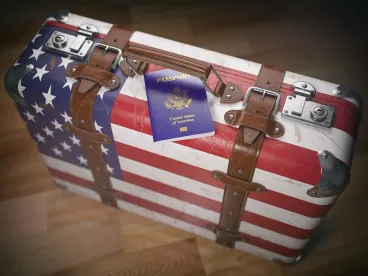In response to the new challenges presented by the coronavirus pandemic, the Department of Homeland Security (DHS) has announced temporary flexibility in the requirements for completing Form I-9, Employment Eligibility Verification, while employers are operating remotely. DHS also has extended the time in which employers may respond to Notices of I-9 Inspection and the time in which to address certain E-Verify case responses. Some states have begun automatically extending the validity of identification cards and driver’s licenses because of COVID-19. For I-9 purposes, DHS has confirmed that employers may accept such documents as valid List B identity documents under certain conditions explained below.
Temporary Deferral of In-Person Inspection of I-9 Documents While Employer Operates Remotely
To complete Form I-9, an employer must meet with its employee to review the document(s) that the employee chooses to present from the I-9 List of Acceptable Documents. The employer must inspect the original document(s) in the presence of the employee to verify a new hire’s identity and employment authorization (Section 2) or to verify an existing employee’s continued employment authorization (Section 3). This in-person physical document inspection must be completed within three business days of hire for new employees and by the date on which employment authorization expires for existing employees for whom reverification is required. With the rapid spread of COVID-19, many employers have begun operating remotely and have struggled to complete in-person document inspection within the required time periods.
To provide some relief to employers that are operating remotely, DHS has announced that it will temporarily defer the in-person document inspection. DHS will allow remote document inspection as follows:
-
Employers may inspect the I-9 documents remotely through email, fax, video link, or other manner until in-person physical inspection can be accomplished.Upon remote inspection, employers must retain copies of the documents with the I-9 Form.Employers also must complete Section 2 or Section 3, as applicable, within the normal time periods for I-9 compliance.
-
Within three business days after normal operations resume, employers must complete the in-person physical inspection of the original documents presented for I-9 compliance.The employee must be physically present during this document inspection.The employer must ensure that the same person who inspected the documents remotely meets with the employee to complete the in-person inspection of the original documents.
-
Employers must make an additional entry on the Form I-9 to state the date of the in-person physical inspection of I-9 documents and to explain why the inspection was delayed.Employers may meet this requirement by stating “Documents physically examined on [FILL IN DATE].COVID-19 delayed physical inspection.”When the in-person inspection relates to Section 2, employers may enter this explanation in the “Additional Information” field that appears under the List B column.If completing a reverification, employers may enter the explanation in Section 3 or in the Additional Information field (with a reference that the note relates to Section 3).
-
Employers that rely on these temporary I-9 procedures must maintain written documentation of the remote onboarding and telework policy for each covered employee.
-
Employers that are operating remotely may use these temporary I-9 procedures for the shorter of (1) three business days after the termination of the national emergency and (2) May 19, 2020.
As mentioned, these flexibility procedures are available only to employers that are operating remotely. Employers that have employees physically present at the work location must comply with all I-9 requirements, including in-person document inspection. If such employers face I-9 compliance issues involving newly hired or existing employees who are quarantined or subject to lockdown protocols because of COVID-19, DHS is likely to exercise favorable discretion toward an employer’s good faith efforts. DHS has stated that it will evaluate compliance efforts in those situations on a case-by-case basis.
Automatic Extension of the Validity of Certain I-9 Documents
The coronavirus pandemic has caused many states to close their department of motor vehicle offices and announce blanket temporary extensions of expiring identification cards and/or driver’s licenses. Among others, California, Colorado, Florida, Illinois, Massachusetts, New York, Texas, Virginia, and Wisconsin have done so. The District of Columbia also has made an extension announcement. The scope and length of these extensions vary greatly.
For I-9 compliance, documents must be valid when presented. DHS has confirmed that employers may accept ID cards and driver’s licenses that show an expiration date on or after March 1, 2020, and are covered by a state’s blanket temporary extension because of coronavirus. To rely on such an ID card or license as a List B identification for I-9 compliance, employers must record the document’s actual expiration date in Section 2 and enter “COVID-19 EXT.” in the Additional Information field. DHS recommends that employers also print the relevant state’s announcement confirming the automatic extension and attach that sheet to the Form I-9.
Automatic Extension of Time to Respond to Notices of I-9 Inspection
In 2020, Immigration and Customs Enforcement (ICE) has issued Notices of I-9 Inspections (NOIs) at a steady pace across almost every state. Because of the pandemic, employers have had difficulty responding to recent NOIs within the short time permitted for doing so. DHS again has responded by granting an automatic extension of time. For any employers that were served NOIs in March 2020 and have not yet responded, DHS has granted until Monday, May 18, 2020, to respond. At the end of this extension period, DHS will determine if a further extension should be granted.
Additional Time to Resolve Certain E-Verify Tentative Nonconfirmations
With one exception, DHS is maintaining its E-Verify compliance requirements during the coronavirus pandemic. Accordingly, the following applies:
-
E-Verify employers must continue to create case inquiries by the end of the third business day after hire.There is no extension of time even when an employer is operating remotely.
-
Best Practice:E-Verify requires that all late case inquiries be explained.Employers that in good faith attempt to comply with the E-Verify timelines, but are delayed by the pandemic should state so.When asked by E-Verify to explain, such employers should select “other” from the options shown and enter “COVID-19” in the associated dialog box.DHS considers the reason for late E-Verify case inquiries when deciding whether to commence an E-Verify audit or special monitoring of the employer’s compliance.
-
-
If E-Verify is unable to confirm employment authorization, it will issue a tentative nonconfirmation (TNC).Regardless of whether the employer is operating remotely, the employer must inform the employee promptly of the TNC and offer the employee the opportunity to contest.
-
Generally, if an employee contests the TNC, E-Verify will grant the employee eight federal working days to resolve the TNC.During the pandemic, E-Verify will temporarily extend the TNC time period when the employee is required to make an in-person visit to an SSA field office or a DHS office.SSA and DHS offices are temporarily closed to most in-person visits by the public. Thus, DHS has stated that it will place the E-Verify case in “interim case status” or “extended interim case status” until the applicable SSA or DHS office reopens to the public.While E-Verify shows that the case inquiry is in an interim status, employers may not terminate or take other adverse action against the employee.
-
If the TNC instructs the employee to telephone DHS or SSA, rather than visit in person, DHS is unlikely to extend the time to resolve the TNC issued in the E-Verify case.
New Version of Form I-9 Mandatory as of May 1, 2020
Employers must begin using the new version of the Form I-9 on May 1, 2020. This deadline has not been extended. The new I-9 states an issuance date of October 21, 2019.




 />i
/>i
